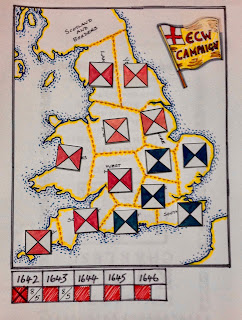After the completion of last weekend's ECW game I decided to add a bit more terrain to the tabletop and play a WW2 game, where I was planning to try out some rule modifications. As it turned out, it was one of those situations where the rule modifications sort of worked, but generated more rule ideas and tweaks, and I ended up playing four WW2 games during the week all using the same terrain setup.
At the end of those games I have some modifications I can now write up, providing I don't get too caught up in painting and modelling.
 |
| Start of a WW2 game |
 |
| A Panther waiting to jump into action |
 |
| An armoured infantry unit prepares to advance |
On the modelling and painting front I seem to have landed myself with three projects underway. This is something I generally try to avoid, as I would generally rather just focus on two projects, a primary one and a secondary project. The secondary project is used to provide a bit of variety when I need a little break from my primary project, and is arranged so it can be completed in bits without having half completed models lying about.
So what are the projects?
- There is the Necromuda (Sci-Fi Skirmish) project, which is meant to be my secondary project, but has been increasing in size with terrain now added into the mix. While I have completed another unit recently, the terrain pieces are taking longer than expected and remain annoyingly unfinished and taking up space.
- My primary project, or part two of the project to be precise, is my WW2 Western Desert project. Part one was the completion of a large part of the Afrika Korps and Commonwealth forces which have allowed me to start gaming. Part two, consisting mainly of Italian forces, is in the post and expected to arrive in a week or so.
- My third project which has just started is my paper soldier project. This was originally going to be War or the Spanish Succession, but has begun with the Jacobite 1745 Rebellion which I bought on a whim.
While waiting to start the second part of my WW2 Western Desert project, which is in the post, and without much thought, I merrily started the third project - Jacobite rebellion. Is this a really a problem? Not really, as the painting of the remaining WW2 Western Desert 6mm models, when they arrive, will not take long and I will be back to two projects. It is just that past experience which has taught me not to have too many half finished projects, and to focus my painting or modelling efforts.
 |
| Latest unit to be completed for my Sci-Fi skirmish games using One-Hour Skirmish Wargames |
Anyway, a quick update on the paper soldier project using the book "Wargame the Jacobite '45" by Peter Dennis. I decided to try increasing the size of the figures. Rather than photocopying to A4 sized paper, I photocopied to A3 sized paper which provides approximately a 50% increase in figure size. This makes them a tad over 40mm in height. I really like the drawings by Peter Dennis and they seem to benefit with the size increase (to my eyes anyway) and also as a bonus become much easier to cut out.
 |
| I was trying to determine my preference for to basing the figures |
 |
| I opted for single row basing. Reasons were: slightly easier to make this way, gives me flexibility as to the rules I may use, and they will be easier to store in a box. |
 |
| I plan to have 9 bases per unit in 3 rows of bases. The base width is 60mm and 20mm depth. |
There will be more on the paper project as it progresses (with no need to paint tartan!)





















































